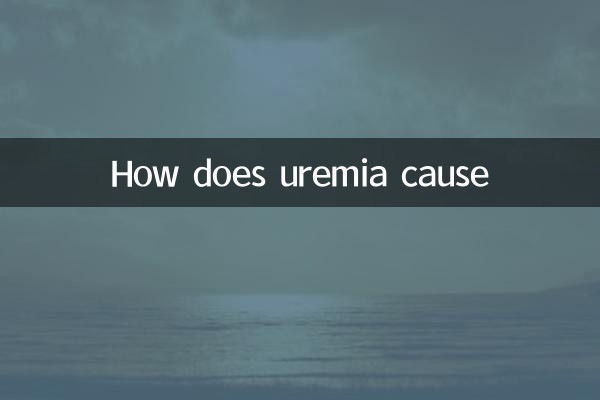How does uremia cause
Uremia is the end-stage manifestation of chronic kidney disease. Due to severe damage to kidney function, it is unable to effectively filter waste and toxins in the blood, resulting in metabolic disorders in the body. In recent years, the incidence of uremia has increased year by year, becoming one of the global public health problems. This article will combine popular topics and hot topics across the network for the past 10 days to structure the cause, high-risk factors and preventive measures of uremia.
1. The main causes of uremia

Uremia is not an independent disease, but the end result of the development of multiple kidney diseases. The following are common causes:
| Cause classification | Specific diseases | Percentage (reference data) |
|---|---|---|
| Primary renal disease | Chronic glomerulonephritis, IgA nephropathy | About 40% |
| Metabolic diseases | Diabetic nephropathy, hypertensive nephropathy | About 35% |
| Secondary renal damage | Systemic lupus erythematosus, gouty nephropathy | About 15% |
| Other factors | Drug-induced renal injury, urinary tract obstruction | About 10% |
2. Analysis of high-risk factors
According to recent medical research and hot discussions, the following factors significantly increase the risk of uremia:
| High-risk factors | Influence mechanism | Preventive advice |
|---|---|---|
| Long-term hypertension | Injury glomerular blood vessels, leading to renal decline | Control blood pressure <140/90mmHg |
| diabetes | Hyperglycemia destroys glomerular filtration barrier | Glycated hemoglobin <7% |
| obesity | Increase the kidney metabolic burden and induce inflammation | BMI <24, waist circumference for men <90cm, female <85cm |
| Drug abuse | Direct nephrotoxicity of non-steroidal anti-inflammatory drugs, antibiotics, etc. | Avoid taking medication for a long time |
3. Early symptoms and diagnosis
The development of uremia usually lasts for years or even decades, and early symptoms are easily overlooked. A typical case that has been hotly discussed on the Internet recently warns that the following symptoms should be wary of:
1.Fatigue, decreased appetite: Toxin accumulation affects digestive system and energy metabolism.
2.Edema: Especially the eyelids and lower limbs, it indicates proteinuria and renal loss.
3.Increased nocturnal urine: Typical manifestations of decreased kidney concentration function.
4.Itchy skin: Phosphorus metabolism disorder leads to calcium and phosphorus deposition.
Diagnosis needs to be combinedSerum creatinine, urea nitrogen, eGFR (estimated glomerular filtration rate)If necessary, renal ultrasound or biopsy will be performed.
4. Prevention and management measures
In combination with recent medical guidelines and hot health topics, the following measures are recommended:
| Measures classification | Specific content |
|---|---|
| Dietary control | Low salt (<5g daily), low protein (mainly high-quality protein), phosphorus-restricted potassium |
| lifestyle | Quit smoking and limit alcohol, moderate-intensity exercise ≥150 minutes per week |
| Regular screening | Hypertensive/diabetic patients check for microalbumin every year |
| Treatment of primary diseases | Strictly control blood sugar and blood pressure to avoid nephrotoxic drugs |
5. Summary
The causes of uremia are complex, but most are related to chronic disease management and bad living habits. Although there are individual differences in the recent hotly discussed cases of "young people staying up late and causing kidney failure" cases on social media, they reflect the public's concern about kidney health. Through early intervention and standardized treatment, the progress of uremia can be significantly delayed and the quality of life can be improved.

check the details

check the details